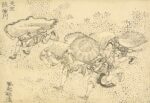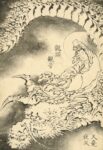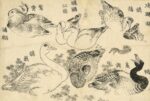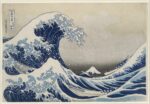 The British Museum has acquired a set of more than 100 illustrations by Japanese master Katsushika Hokusai that were lost for 70 years. Hokusai, today internationally famous for his iconic Great Wave print, created 103 drawings in 1829 for a book called Great Picture Book of Everything but for reasons still unknown to this day, it was never published.
The British Museum has acquired a set of more than 100 illustrations by Japanese master Katsushika Hokusai that were lost for 70 years. Hokusai, today internationally famous for his iconic Great Wave print, created 103 drawings in 1829 for a book called Great Picture Book of Everything but for reasons still unknown to this day, it was never published.
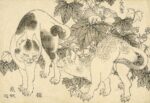 His hand-inked preparatory drawings were acquired by French Art Nouveau jeweler Henri Verver (1854-1942) who was one of the first European collectors of ukiyo-e woodbloock prints, an art form that Hokusai embraced and transformed. They last appeared on the public record in 1948 when they were sold at auction and then disappeared into the penumbra of anonymous private holdings. The collection emerged again last year and the British Museum was able to arrange their purchase thanks to a grant from the Art Fund.
His hand-inked preparatory drawings were acquired by French Art Nouveau jeweler Henri Verver (1854-1942) who was one of the first European collectors of ukiyo-e woodbloock prints, an art form that Hokusai embraced and transformed. They last appeared on the public record in 1948 when they were sold at auction and then disappeared into the penumbra of anonymous private holdings. The collection emerged again last year and the British Museum was able to arrange their purchase thanks to a grant from the Art Fund.
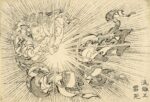 As might suit the illustrations for a book about everything, the drawings depicts a variety of subjects including mythology, literature, animals, plants and landscapes. Most of the drawings refer to subjects from ancient China, India, Southeast Asia and Central Asia, motifs that appear nowhere else in Hokusai’s oeuvre.
As might suit the illustrations for a book about everything, the drawings depicts a variety of subjects including mythology, literature, animals, plants and landscapes. Most of the drawings refer to subjects from ancient China, India, Southeast Asia and Central Asia, motifs that appear nowhere else in Hokusai’s oeuvre.
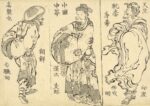 They were made during a period of great hardship in Hokusai’s life. He was 70 years old and had suffered a stroke, been widowed and was close to destitute because of his grandson’s gambling debts. He produced very little artwork during this time, which makes the drawings all the more significant.
They were made during a period of great hardship in Hokusai’s life. He was 70 years old and had suffered a stroke, been widowed and was close to destitute because of his grandson’s gambling debts. He produced very little artwork during this time, which makes the drawings all the more significant.
Tim Clark, Honorary Research Fellow of the British Museum, said, “These works are a major new re-discovery, expanding considerably our knowledge of the artist’s activities at a key period in his life and work. All 103 pieces are treated with the customary fantasy, invention and brush skill found in Hokusai’s late works and it is wonderful that they can finally be enjoyed by the many lovers of his art worldwide.”
The 103 drawings and the original wood box they came in have been digitized and can be browsed in extreme close-up in the British Museum Collection online.
